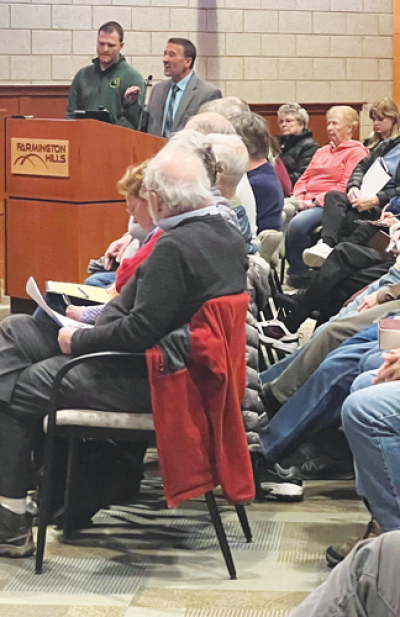
Chad Fedewa, left, a wildlife biologist at the Michigan Department of Natural Resources, and Bryan Farmer, the deputy director for special services for the city of Farmington Hills, gave a presentation about urban deer management at a study session before Farmington Hills City Council members and multiple residents at Farmington Hills City Hall March 24.
Photo by Gena Johnson
FARMINGTON HILLS — Farmington Hills City Council members met for a study session March 24 to find solutions to reduce the deer population in the community.
The study session drew the attention of multiple residents, as it was standing room only inside City Council chambers.
Residents expressed concerns about the growing deer population, increased vehicle-deer collisions, the possibility of contracting Lyme disease, deer encroaching on their property, and plants and landscaping being destroyed by the deer, causing expensive property damage.
During the study session it was reported that in 2023 there were nearly 288,000 vehicle-deer crashes in Michigan, including 2,100 in Oakland County. In Farmington Hills, there were 144 reported crashes involving deer in 2023 — an 18% increase over 2022.
Following the study session, residents and officials provided comments to the Press.
“The way the deer are dying now is cruel,” Farmington Hills resident Coleen Redmond said. “They are being hit by cars and left dying in agony. We had a situation in the spring where a deer was hit by a car and made its way into someone’s backyard and the police had to come out and put that poor animal down.”
According to Redmond, deer are on her property constantly.
Alan Redmond has also taken notice of the deer.
“It’s a herd,” he said.
The Redmonds have lived in Farmington Hills for approximately 10 years and have had issues with deer since moving to the community.
According to Coleen Redmond, the deer have been in their front yard, their back yard, on their patio, and in their driveway.
“They are everywhere,” she said. “We spent about $8,000 this summer, just replacing the shrubbery in our front yard.”
She noted that the deer are not afraid of humans.
Although the Redmonds don’t have any pets, according to Coleen Redmond, a buck used its antlers to toss a dog that is owned by someone who resides in their community.
“They almost lost their pet,” Coleen Redmond said.
Bryan Farmer, the deputy director of Farmington Hills’ special services department, shared one of the options that has been discussed to control the deer population.
“The combination of hunting and a cull is what we proposed — highly-organized hunts,” Farmer said. “They are really going to be in specific locations.”
Farmer said the hunts “will be regulated.”
According to Farmer, organized hunts are when officials know who is hunting and how many people are hunting. In addition, hunters will go through a shooting test for bows or crossbows.
Councilwoman Valerie Knol said that residents have inquired about non-lethal means of reducing the deer population.
Chad Fedewa, a wildlife biologist for the Michigan Department of Natural resources, shared one of the options that has been discussed.
“Sterilization and birth control aren’t effective,” Fedewa said.
Part of Fedewa’s rationale is that deer are designed to procreate.
Transporting deer to another location would not work either, according to Fedewa. From his perspective, it would only further increase the deer population in the area in which they are transported.
Using plants and sprays that deer are adverse to also does not work, according to Farmer.
“Our residents have tried it all,” Farmer said.
According to Farmer, plants and sprays don’t reduce the deer population. They eventually eat the plants because they are hungry, and if they are adverse to a plant or spray, it is eventually eliminated from their body.
Farmer and Fedewa are in agreement that the only way to reduce the deer population is through lethal means.
“There’s not many predators of deer on the landscape in southern Michigan, so the only way to manage those populations is through legal regulated hunting,” Fedewa said.
Those who would like an immediate solution are likely to be disappointed.
According to Fedewa, even if a cull and legalized hunting is approved, it may take years to notice a difference in the deer population.
A draft of a resolution that was presented at the study session included options such as organized hunts, beginning in 2027, a temporary suspension of firearm ordinances during culls and regulated hunts, a deer management report that is provided to the mayor and City Council members on an annual basis, and a deer management review every five years, as part of a parks and recreation master plan.
Although no votes were taken at the study session, the issue will be voted on at a City Council meeting that is set to take place at 7:30 p.m. April 28 on the second floor of The Hawk.
 Publication select ▼
Publication select ▼






















